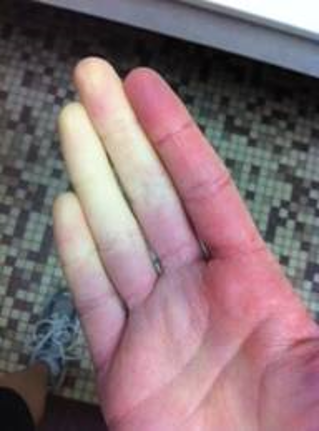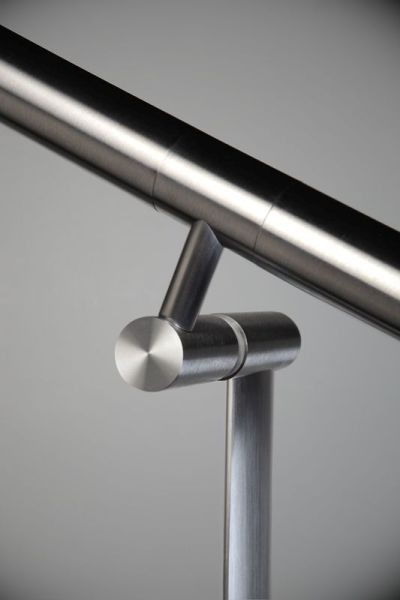Thermal Protection Guard™ by HDI provides protection against hot or cold handrail surfaces
Thermal Protection Guard™ by HDI is a permanent, transparent, insulation layer to help protect users against temperature extremes on external handrails.
We have all held railings that are uncomfortably cold in the winter or too hot in the summer. While this is unpleasant for most, for people with Raynauds Phenomenon it can be dangerous.
What is Raynaud’s Phenomenon?
Raynaud’s phenomenon is named after the French physician Maurice Raynaud who first described Raynaud’s phenomenon in a young woman in 1862. In people who have Raynaud’s, the small blood vessels in the extremities are over-sensitive to changes in temperature. This causes a Raynaud’s attack where the fingers sometimes change colour (but not always) from white, to blue, to red. Sometimes the fingers may become painful or have a tingling sensation during the event. Symptoms of a Raynaud’s attack can last from a few minutes to several hours. For more information on Raynaud’s phenomenon please follow this link.

Comments from individuals suffering with this condition:
-
- “My hands in particular can be so bad I can’t go into a shop with air conditioning or get something out of the fridge (I have to wear thermal gloves for the freezer). Over the last couple of years my nose is suffering a lot.”
- “Sometimes simply holding metal cutlery will set my hands off, or walking down a supermarket freezer aisle!”
- “My fingers will go as soon as the temperature drops from hot/warm to a few degrees cooler, whether that’s just getting out of bed, moving from one room to another or going outside and just moving from warm sun to slightly cooler shade in the summer.”
Over time, the fleshy parts of the fingertips (on the palm side) may lose tissue and become tapered and thin instead of staying plump. In more severe cases, blood flow may be so restricted during the episodes that the tissue on the fingertips may actually die due to the lack of nutrients and oxygen. This can potentially cause open sores to develop. These can be very painful and are prone to infection if not treated. Trauma to the fingertips, even minimal trauma, appears to increase the possibility of this happening especially with outdoor handrails.
The British Standard BS 8300 and approved document M are long regarded as the most authoritative guidance available to architects. They provide detailed guidance regarding handrail specification and general usage guidance.
One of the recommendations from the above mentioned standard is: “In locations subject to extreme temperatures, handrails should be made of materials which do not become excessively hot or cold to touch.”
Notwithstanding the normal design considerations to permit accessibility this legislation provides an obligation and responsibility for architects and specifiers to make sure handrails are suitable for the environments in which they are to be used.
Solution: Thermal Protection Guard™

HDI Railings Thermal Protection Guard (TPG) provides a risk-free solution for specifications involving external stainless steel handrails. HDI’s TPG has been developed and tested using a designated custom micron thickness to maximise insulation whilst maintaining optimal surface finish under laboratory test conditions. This product finish will allow specifiers an option to use stainless steel materials while still offering users suffering from Raynaud’s phenomenon protection.
To specify simply add: HDI Railing System material finish to include Thermal Protection Guard (TPG) to the material category of the specification. Please see link to RIBA Product Selector site.
CORROSION AND WEAR
TPG has been tested to BS EN ISO 9227:2017
TPG is effective only when applied by an applicator authorised by HDI onto HDI products
The TPG coated HDI stainless parts were tested to 1000 hours Neutral Salt Spray (NSS) to EN ISO 9227. HDI 304 SS components showed little or no sign of wear or corrosion. It details the apparatus, reagents and procedures to be used in conducting neutral salt spray (NSS); acetic acid salt spray (AASS); and copper accelerated acetic acid salt spray (CASS) tests of metallic materials, with or without permanent or temporary corrosion protection. It also describes how to evaluate the corrosivity of the test cabinet environment. It provides a systematic means of testing the corrosion resistance of metallic materials. It’s particularly useful for detecting discontinuities – such as pores and other defects – in certain metallic, organic, anodic oxide and conversion coatings. Replaces BS EN ISO 9227:2012
FIRE RATING
TPG is fully Fire rated to EN 13501-1:2010.
Reaction to fire classification: A2-S1, D0
The EN‐classification does have the following standards :TPG Results : Class A2 (limited combustible materials) Class S1 (Very limited smoke development) Class d0 (No burning droplets or particles)
For more information please contact:
Neil Andrews
![]()
HDI Railing Systems, LTD.
Mobile +44 7383 436490
Email [email protected]
www.hdirailings.co.uk

